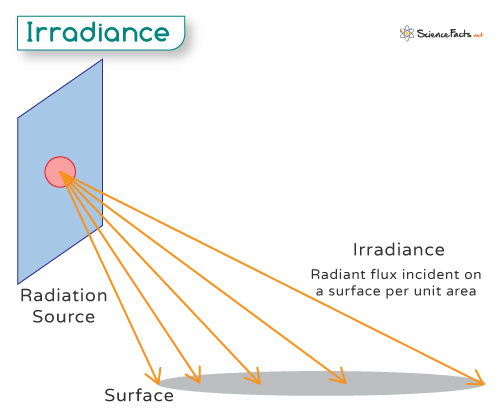Irradiance
Irradiance refers to the amount of radiant power per unit area received from a radiation source. In other words, it measures how much energy is delivered to a given area from a specific source.
For example, when we stand outside in the sun, we feel its warmth due to the Sun’s energy reaching us. To measure how much of this solar energy is hitting a specific area, like a square meter of ground, we use irradiance.
Formula
Mathematically, irradiance is defined as the power per unit area and can be calculated using the following formula:
Where:
– I is the irradiance
– P is the power of the electromagnetic radiation hitting the surface
– A is the area over which the power is distributed
Among its various forms, solar irradiance is a specific type that focuses on sunlight reaching the Earth’s surface.
Solar Irradiance
Solar irradiance refers to the power per unit area received from the Sun’s rays at a specific location on Earth’s surface. It is a critical parameter in understanding and harnessing solar energy for various applications, including solar power generation and passive solar design. Solar irradiance varies based on geographic location, time of day, atmospheric conditions, and the angle of incidence of sunlight. As sunlight penetrates the Earth’s atmosphere, it undergoes scattering, absorption, and reflection, leading to variations in the solar irradiance received at the surface.
Types of Solar Irradiance
Solar irradiance can be categorized into different components to understand its characteristics better.
- Global Horizontal Irradiance (GHI) represents the total solar power received on a horizontal surface, accounting for direct sunlight, diffuse radiation from the sky, and ground-reflected radiation.
- Direct Normal Irradiance (DNI) focuses on the direct beam of sunlight that reaches a surface perpendicular to the Sun’s rays, excluding diffuse and reflected radiation.
- Diffuse Horizontal Irradiance (DHI) quantifies the scattered sunlight in the sky, omitting direct and ground-reflected radiation.
How to Measure Solar Irradiance
To measure irradiance, scientists use instruments called pyranometers or radiometers. These devices are designed to capture and measure the amount of sunlight (or other electromagnetic radiation) falling on a given area
Applications of Irradiance
Irradiance plays a crucial role in enhancing the efficiency and performance of solar technologies and in various non-solar domains.
Here are some applications of solar irradiance:
- Solar Power Generation: Engineers measure the irradiance to determine how much electricity a solar panel can generate. Higher irradiance means more sunlight and more potential electricity. This helps in designing solar power systems and determining where to place solar panels for maximum efficiency.
- Solar Farm Planning: When setting up a solar farm, engineers measure the irradiance at different locations to choose the best spot. The location with the highest irradiance will produce the most energy, making the solar farm more efficient and cost-effective.
- Climate Science: Scientists study irradiance to understand how much solar energy the Earth receives and how it affects global temperatures and climate patterns. This information helps predict weather, understand climate change, and develop models for future climate scenarios.
- Agriculture and Crop Management: Farmers and agricultural scientists use irradiance data to understand the amount of sunlight crops receive. Different crops need different amounts of sunlight. By knowing the irradiance, farmers can choose the best crops for their land and optimize planting and harvesting times to maximize yields.
Here are some applications in various other fields:
- Medical Imaging and Therapy: Irradiance is used in X-rays and radiation therapy to diagnose and treat conditions, ensuring the appropriate radiation dose is administered.
- Photovoltaic Testing: Testing and calibrating solar panels uses irradiance under artificial light sources to simulate different lighting conditions and ensure efficiency and reliability.
- Material Testing and Analysis: Irriradiance can evaluate the properties of materials under controlled light exposure, such as testing the durability of coatings, paints, and other materials exposed to artificial UV light.
- Environmental Monitoring: Irradiance sensors are used to monitor and study artificial radiation sources in the environment, including industrial emissions and urban lighting pollution.
-
References
Article was last reviewed on Friday, June 7, 2024








